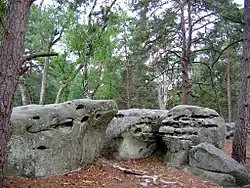Forest of Fontainebleau
The forest of Fontainebleau (French: Forêt de Fontainebleau, or Forêt de Bière, meaning "forest of heather") is a mixed deciduous forest lying sixty kilometres (37 mi) southeast of Paris, France. It is located primarily in the arrondissement of Fontainebleau in the southwestern part of the department of Seine-et-Marne. Most of it also lies in the canton of Fontainebleau, although parts of it extend into adjoining cantons, and even as far west as the town of Milly-la-Forêt in the neighboring department, Essonne. Several communes lie within the forest, notably the towns of Fontainebleau and Avon. The forest has an area of 250 km2 (97 sq mi).[1]



Fauna and flora
The most common trees in the forest are: oak (44%), Scots pine (40%), and European beech (10%). Three thousand species of mushrooms have been discovered. The forest is also home to approximately seven thousand animal species, five thousand of which are insects.
Flowers
- Tor-grass (Brachypodium pinnatum)
- Service tree of Fontainebleau (Sorbus latifolia), which is under national protection
- Snowy mespilus (Amelanchier ovalis), under national protection
- Common juniper (Juniperus communis)
- Orchids
- Violet limodore (Limodorum abortivum)
- Red helleborine (Cephalanthera rubra), under national protection
- Meadow rue (Thalictrum minus), under national protection
- Peach-leaved bellflower (Campanula persicifolia)
- Wild madder (Rubia peregrina)
- Burnet rose (Rosa pimpinellifolia)
- Cranesbill (Geranium sanguineum)
- Vincetoxicum (Vincetoxicum hirundinaria)
- Red feather clover (Trifolium rubens), under national protection
Birds
- Great spotted woodpecker (Dendrocopos major)
- Lesser spotted woodpecker (Dendrocopos minor)
- Great tit (Parus major)
- Blue tit (Parus caeruleus)
- Chiffchaff (Phylloscopus collybita)
- Willow warbler (Phylloscopus trochilus)
- Bonelli's warbler (Phylloscopus bonelli)
- Blackcap (Sylvia atricapilla)
Rock shapes
The place is also known for peculiar rock shapes which resemble elephants, tortoises, crocodiles and are believed to be natural formations.[2]
Fictional and media depictions
- The painters of the Barbizon School found the forest a convenient location for their unadorned, realist depictions of nature.
- The forest is the main location of the trilogy Les Fourmis by Bernard Werber.
- In the novel The Scarlet Pimpernel by Baroness Orczy, Sir Percy and Margeurite St Just wander in this forest during the happy period of their courtship.
- Act I (the prologue in the Italian version) of Verdi's opera, Don Carlos, is set in the forest of Fontainebleau.
- A scene in the 1852 play The Corsican Brothers, where a duel takes place, is set in the forest of Fontainebleau.
- Chapter 6 of the film serial Les Vampires takes place in Fontainebleau Forest.
- The map "Castle Rock" in the game Alliance of Valiant Arms takes place in the Fontainebleau Forest.
- The Santalune Forest location in Pokémon X and Y is based loosely on Fontainebleau Forest.
- DC's Legends of Tomorrow (Season 2, episode 2) battle an enhanced Baron Krieger and several Nazis after the Waverider lands in the Fontainebleau Forest.
- Louis Malle's autobiographical film, Au Revoir Les Enfants, was filmed and set in and around Fontainebleau.
 Python Crushing a Gnu. Setting is the Forest of Fontainebleau. The Walters Art Museum.
Python Crushing a Gnu. Setting is the Forest of Fontainebleau. The Walters Art Museum.
See also
References
- "Fontainebleau". Paris Digest. 2018. Retrieved 2018-11-28.
- "Strange Rocks At Fontainebleau". Retrieved 22 March 2015.
External links
 Media related to Forest of Fontainebleau at Wikimedia Commons
Media related to Forest of Fontainebleau at Wikimedia Commons- Fontainebleau, forêt d'émotions Official webpage from Office National des Forêts (in French)
